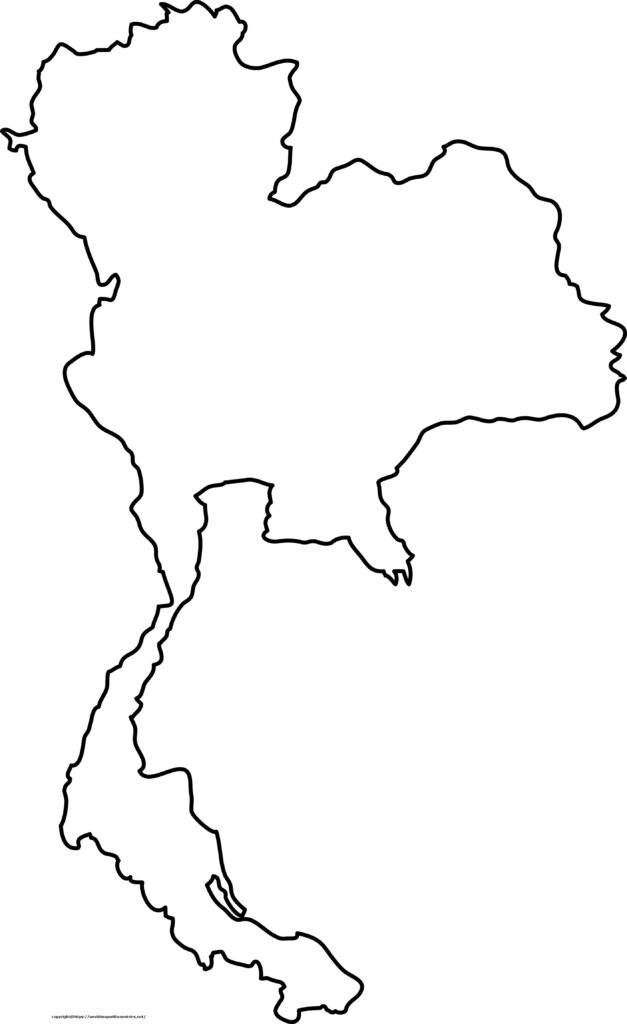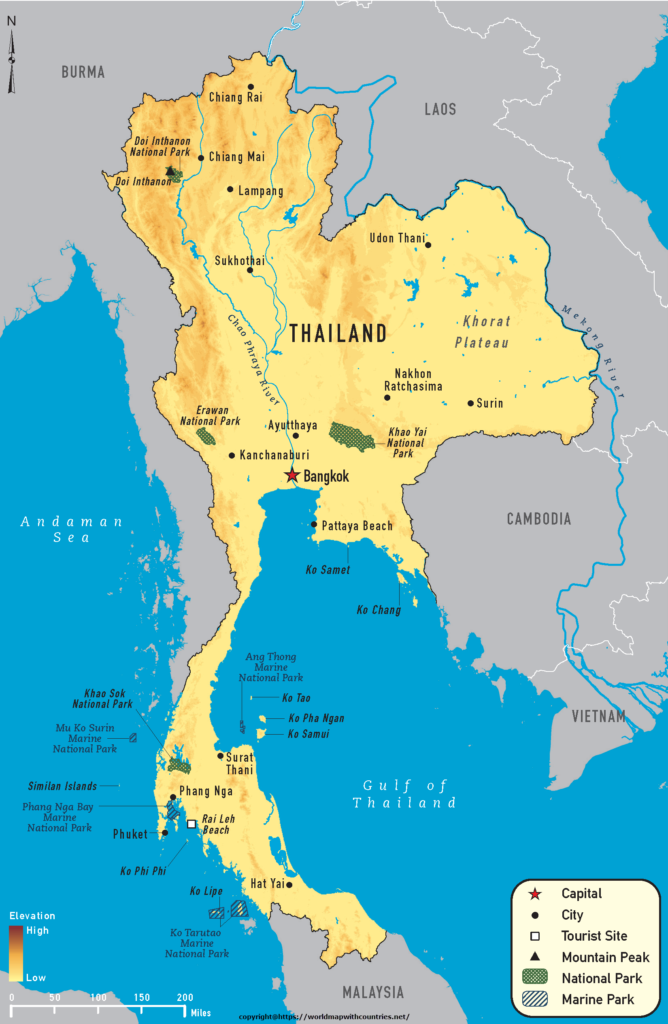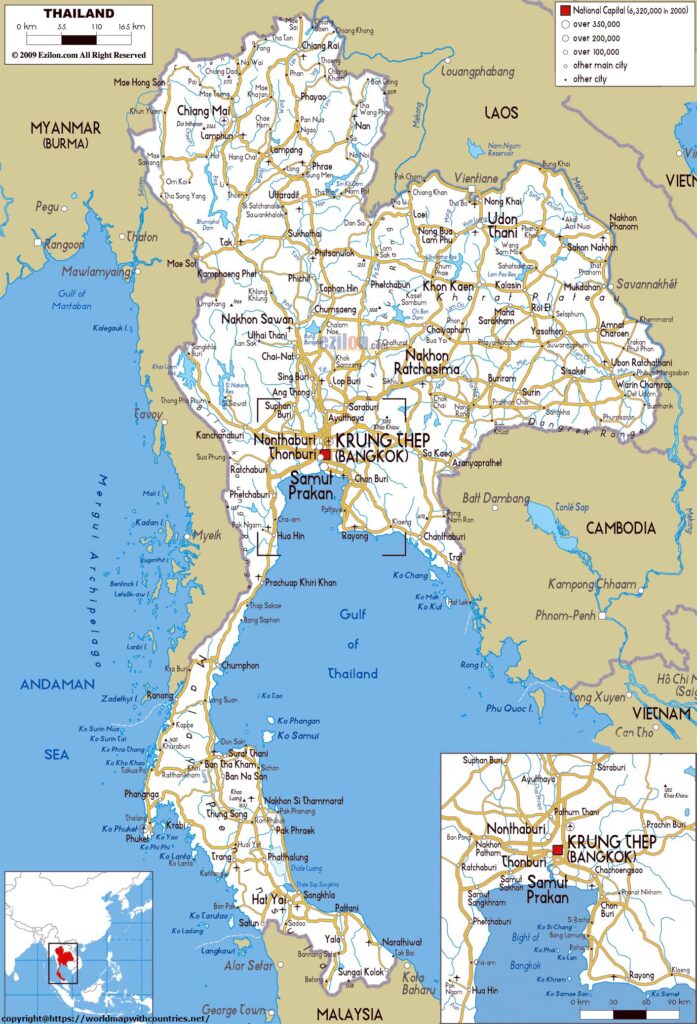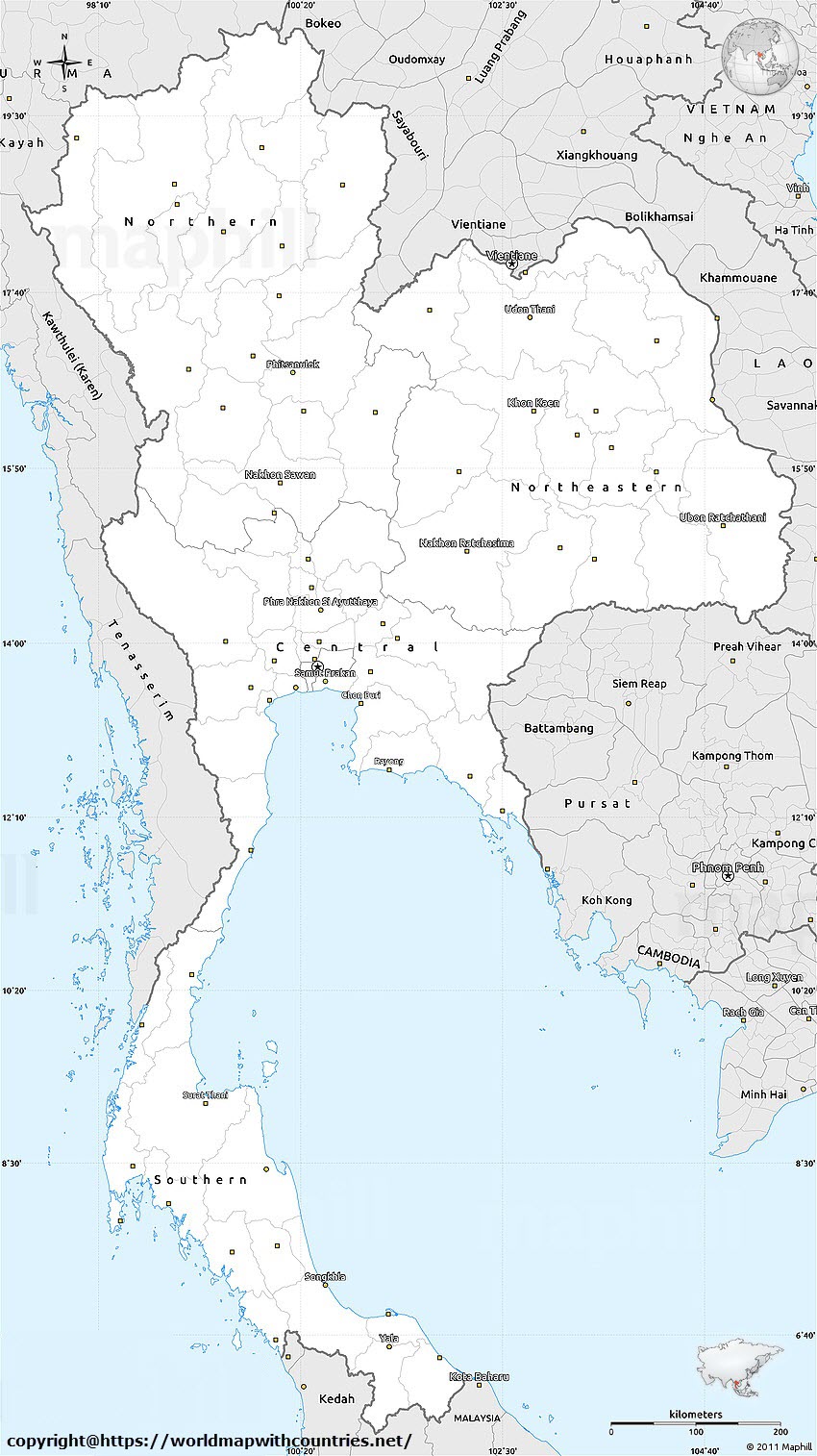Thailand is a country situated in Southeast Asia. Get help from this Free Printable Blank map of Thailand and Thailand Map outline in PDF to gain knowledge about the geographical and demographical heritage of the country. Siam was the name for the country until 1939. You can also check out our printable world map as well.
Table of Contents
Blank Thailand Map Outline
Printable Map Of Thailand
Labelled Map Of Thailand
Thailand Map With State
Best States to visit in Thailand
Thailand Customs, Beliefs, And Culture
Thai Customs
Religion In Thailand
Societal Values In Thailand
Largest Ethnic Groups In Thailand
Blank Thailand Map Outline

Thailand covers a total area of 513,120 sq. km in the Indo-Chinese Peninsula. The country has a varied landscape ranging from low mountains to fertile plains to sandy beaches. Fold peaks dominate the country’s landscape to the north and west. These mountains extend southward (in a narrow strip) along the Burma border to the northern edges of Malaysia. As marked on the map by an upright yellow triangle, the country’s highest point is Doi Inthanon, whose summit peaks at 8,451 ft. (2,576 m). To the northeast is the Khorat Plateau. It is a region of rolling low hills and small, shallow lakes that drain into the Mekong River system on its border with Laos. The Chao Phraya River basin lies in the center of the country. The Chao Phraya River, which flows for 231 miles (372 km), is home to some of the most historically significant and densely populated settlements of Thailand; the river and its tributaries drain into a delta south of Bangkok. The southeast represents the maritime corner of the central region.
Along Thailand’s southern peninsula (Isthmus of Kra), the land fades into mangrove swamps. Numerous islands are found off the coastline, with Phuket being the most famous. The country’s lowest point is the Gulf of Thailand (0 m). Chiang Mai, Nakhon Ratchasima, Khon Kaen, Udon Thani, Pattaya, and Hat Yai are significant cities. Mount Inthanon is the highest point at wat2,585 meters, in northwestern Thailand, near the historical city of Chiang Mai. Chao Phraya in the west and the Mekong in the east are the central drainage systems with 3threeother rivers Ping, the Yom, and the Nan. You can download the blank Map of Thailand here for free:
Printable Map Of Thailand
From the printable Map of Thailand, you will discover that the country is surrounded by Cambodia, Laos, Myanmar, and the Gulf of Thailand from the south. In the area it is similar to Spain and France. Thailand is located in the tropics with its diversified ecosystem with hilly forests, rice and paddy fields in the central, and an extensive coast in the southern peninsula. In the 20th century, it was an agricultural country then later, its population started to moving Bangkok and other major cities, and the urbanization began

Labelled Map Of Thailand
The labelled Map of Thailand shows that Thailand lies in the tropical monsoon zone, due to which there is hot to cold, dry to wet all types of weather can be seen. May have warm humid air towards the Indian Ocean, rainfall in September, then in November and February winds blows opposite to may ii. e. towards north and temperature becomes more relaxed March, and April has air with a period intranodal.

Thailand Map With State
Tai, Malay, Mon, and Khmer are the primary languages used in Thailand. The country provided a home for many immigrants from China and South Asia. Thailand is predominantly Buddhist; 94% of the population practice Buddhism. Five percent of the population practice Islam, while Christianity and other religions account for 1%. The Theravada school is the main form of Buddhism practiced in Thailand. It is supported by the Thai government and institutions in the country. Monks and religious leaders received beneficiaries from the government, including free healthcare and public transport. The belief influences Buddhism in traditional, ancestral and natural spirits that have been incorporated into the religion’s cosmology. Most people in Thailand build miniature houses outside their primary homes because they believe spirits will occupy them.

Best States to visit in Thailand
-
- Bangkok : One of the most popular places to visit in Southeast Asia, Thailand´s capital, is a remarkable city with so much to see and do. With skyscrapers dominating the skyline, expansive markets spreading through the streets, and many glimmering shrines and temples dotted about, it’s easy to see why many people head here.
The Grand Palace is a must-see in this thriving city, as is the impressive temple of Wat Pho with its giant Reclining Buddha. On top of all this, Bangkok has a bustling nightlife and sumptuous Thai cuisine, which helps attract travelers, many of whom head to Khao San Road, the center of the tourist area.
-
- Chiang Mai: With over 300 temples in the city, there are loads of cool places to discover! Chiang Mai is a charming and laidback city perfect for relaxing after a hectic time travelling around the country. Why not indulge yourself with some Thai massages or treat your taste buds to some of the wealth of delicious street food on offer?
The main draw here is its quaint old town in the city’s center with peaceful narrow lanes to wander and explore. The most famous temple Wat Phrathat Doi Suthep, lies just outside the city on a hilltop overlooking Chiang Mai – head here for a fantastic view.
-
- Ayutthaya: Not far from Bangkok lies the historical Ayutthaya, once the largest city in the world back in 1700! Although much of the town was destroyed, the incredible remains and ruins hint at Autthaya´s glorious past.
Exploring the ancient sites such as the stunning Wat Phra Si Sanphet and the awe-inspiring Wat Phu Khao Thong is a mesmerizing experience. After having had your fill of the plethora of historical sites, head to the floating market in the city. You can take in the market’s delights by boat, floating around peacefully.
- Chiang Rai: Chiang Rai is located in the country’s far north and is most famous for the jaw-droppingly beautiful White Temple that shines so brightly in the midday sun. Incredible to behold, the temple needs to be seen to be believed with its unique features and dazzling architecture.
Many people use the city itself as a base to explore the surrounding area, which includes some stunning scenery and access to the Golden Triangle. Lying at the point where Laos, Myanmar and Thailand meet, visiting the Golden Triangle is a bit anticlimactic, if truth be told, as there is not that much there. The best thing to see here is the Hall of Opium which is a great museum that explains the role of the drug in the area´s local history and the world in general. Afterwards, head to the lovely Khun Korn waterfall to refresh and revitalize yourself for the rest of your trip!
Thailand Customs, Beliefs, And Culture
The Kingdom of Thailand is located in Southeast Asia. It is divided into four regions and 76 provinces. Thailand is the 50th largest country by area and is home to over 68 million people. Ancient Thai, Chinese, and Indian traditions influence the present Thai culture. The country’s diverse geography, stunning scenery, and friendly people have earned it the “Land of a Thousand Smiles”.
Thai Customs
Thailand is inhabited by several ethnic groups, many of which are marginalized. These ethnic groups are also found in Cambodia, Malaysia, Laos, and Myanmar and have influenced the traditional, national and global culture of Thailand. Chinese immigrants have significantly influenced the country’s culture, especially in major cities like Bangkok. The greeting is an integral part of the social culture of the Thai. When two people meet, the younger initiate the greeting process and the two will join hands with fingertips pointing upwards. Marriage is also an essential part of society; once a man and a woman are married, they are expected to perform their roles in the house and community. Although the government has contemplated legalizing same-sex marriage, most people consider it immoral and unacceptable. Weddings are considered religious events that are presided over by monks. The Thai society consists of large extended families that constantly share meals with family members. The country’s staple food is rice, consumed alongside another dish. Traditionally people in Thailand have meals on the floor mat and eat using their right hand.
Religion In Thailand
Thailand is predominantly Buddhist; 94% of the population practice Buddhism. Five per cent of the population practice Islam, while Christianity and other religions account for 1%. The Theravada school is the main form of Buddhism practiced in Thailand. It is supported by the Thai government and institutions in the country. Monks and religious leaders received beneficiaries from the government, including free healthcare and public transport. The belief influences Buddhism in traditional, ancestral and natural spirits that have been incorporated into the religion’s cosmology. Most people in Thailand build miniature houses outside their primary homes because they believe spirits will occupy them.
Societal Values In Thailand
Social and cultural values in the country are deeply influenced by religion, considering that 94% of the population practices Theravada Buddhism. The most important values in the country include self-control, respect, and a non-confrontational attitude. Public displays of anger or telling lies are a great shame for the people. The social status hierarchy characterizes all interactions; it is mandatory to respect the elders and those in higher social positions. People with prestigious jobs such as doctors, monks, politicians, and important public figures are revered. The entire Thai society is built around the family. The newlywed couple is expected to set up their household, but it is common for extended families to live together. Although the society is male-dominated, women command considerable respect traditionally and by law.
Largest Ethnic Groups In Thailand
The Kingdom of Thailand is located in the Southeast Asia region and covers 513,000 square kilometers. The country has 67 million people, making it the world’s 20th most populous country. The majority of Thailand’s population lives in rural areas, especially around the rice-growing regions of central and northern regions. Thailand is a diverse country with several ethnic groups. However, the Thai ethnic group accounts for 92% of the population, while the remaining 8 % of the population belongs to the other ethnic minority. Migrants from neighboring countries such as Laos, Myanmar, and Nepal have contributed to the number of non-residents of Thailand, totaling over 4 million. The largest ethnic groups in Thailand are looked at herein.
- Thai: The Thai people, initially referred to as Siamese by Westerners, is the ethnic majority and the leading ethnic group in Thailand. They form part of the Tai ethnolinguistic people found in Southeast Asia. The Thai people speak the Thai language of different variations in different regions. The Thai ethnic group includes central Thai, northern Thai, southern Thai, and Isan people. The ancient Tai people to which the Thai belong migrated southwards between the 8th and 10th Centuries and settled in Chao Phraya Valley. They extended their kingdoms into present-day Thailand, where they were engulfed in Theravada Buddhism of the Mon and Khmer, explaining the mixture of current Thai culture. Over 60 million Thai people live in Thailand, representing 91.5% of the population. Several other Thais can also be found in the US, Southeast Asia, Europe, and United Arabs Emirates. The Thai people are predominantly Theravada Buddhists with unique religious practices, including ancestor worship. They also believe in household spirits and ghosts. Tham bun or merit-making is a common practice done by food, other donations to the monk and contributions to the maintenance of the temple.
- Khmer: The Khmer people are native to Cambodia and belong to the larger Austroasiatic Language Family. They speak the Khmer language, and most follow the Khmer variation of Buddhism. In Thailand, the Khmer people are slightly over one million, which is 2.3% of the total population and live in the provinces of Surin, Buriram, and Sisaket. The Khmer are the oldest ethnic group in Southeast Asia, arriving in the area over four thousand years ago. They brought with them agricultural practices, including rice plantation and bronze. The modern Khmer identify their ethnic identity with their religious practices and beliefs, which are partially influenced by Theravada Buddhism’s worship of ancestors and Shamanism. They also celebrate many religious holidays throughout the year, including Pchum Ben (Ancestors’ Day). The majority of Khmer are confined to rural areas due to rice farming.
- Malay: The Malays belong to the Austronesian groups of peoples and are generally found in the southern regions of Thailand. They are of diverse genetic and culture due to the several years of immigration and assimilation by various regional tribes and ethnic groups. The Malays are coastal traders with solid cultural practices. The ancient Malays were animists, but with the arrival of other religions between the 12th and 15th Centuries, most of them became Sunni Muslims, and Malays observed most of the major Islamic holidays and festivals. Clothing is highly regarded within the community as an item of beauty, power, and status.

